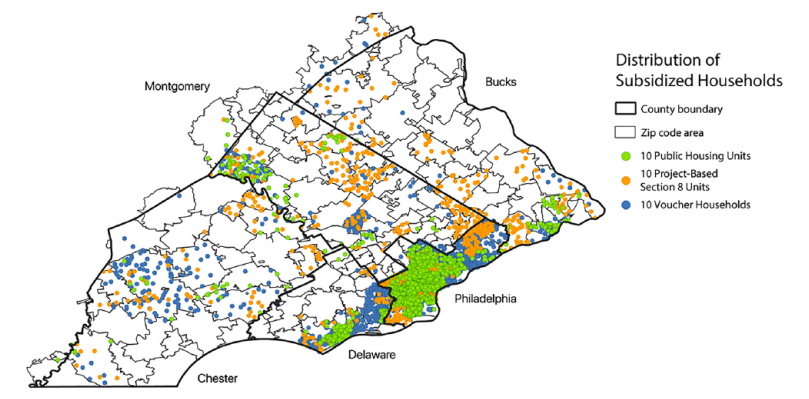|
|
PUBLICATIONS |
|
|
REPORT
Katharine Nelson, Chi-Hyun Kim, Anna Duan, Shihang Yan, and Rebecca Yae | January 2024
On February 1, 2024, the last of the City of Los Angeles’ COVID-19 renter protections will expire and renters who still owe rent from October 1, 2021, to January 31, 2023 must pay their debts to avoid eviction. Up to 93,000 households may owe rent from this period, which makes them newly vulnerable to eviction on February 1. Our surveys of landlords and tenants indicate that large landlords who own fifty or more units are most likely to pursue eviction once protections expire, and that tenants who live in large apartment buildings were more likely to report owing rent from this period. While the City’s recent emergency rental assistance program is addressing some of the outstanding debt from the pandemic, additional targeted outreach and programming may further reduce destabilization of households. |
|
REPORT
Rebecca Yae, Sophie Siebach-Glover, Andrew Aurand, Meredith Abel | July 2023
In response to the COVID-19 public health emergency, more than 500 state, local, tribal, and territorial emergency rental assistance programs were created using funds made available through the U.S. Department of the Treasury’s (Treasury) Emergency Rental Assistance (ERA) program. Despite the ongoing needs of low-income renters, Treasury’s ERA program is quickly winding down. As of July 2023, only 15% of programs were still open to new applications for assistance. The closure of these programs raises the question of what will become of the infrastructure that was established to administer Treasury ERA programs, as well as what resources will remain for households in need of emergency assistance. Here, the Housing Initiative at Penn (HIP) and National Low Income Housing Coalition (NLIHC) present findings from surveys and semi-structured interviews with ERA administrators exploring these questions. |
|
REPORT
Deshonay Dozier, Katharine Nelson, Anna Duan, and Isabel Harner | February 2023
A network of more than 130 nonprofit organizations in California worked to conduct outreach to low-income tenants about pandemic rental assistance. Most of these organizations also supported tenants during the application process. In this report, we present findings from a detailed survey of these organizations, which asked about their perceived effectiveness, their experience assisting tenants, and their perceptions of various aspects of the rollout of the California COVID-19 Rent Relief Program. Our findings underscore the importance of nonprofit partners in spreading the word about emergency rent relief, but also the logistical challenges involved in coordinating these efforts. |
|
REPORT
|
|
REPORT
|
|
REPORT
Katharine Nelson, Cypress Marrs, Yihan Zhang | July 2022
Initial findings from our independent evaluation of the California Emergency Rental Assistance Program. California’s Department of Housing and Community Development ran the largest rent relief program in the country. Between March 2021 and the end of March 2022, one out of ten California renters applied for assistance paying their rent from the State. |
|
REPORT
Claudia Aiken, Yeonhwa Lee, and Sydney Goldstein | June 2022
HIP partnered with Community Legal Services (CLS) to survey over 6,000 Philadelphia renters, one of the largest such surveys ever conducted in the city. The results capture challenges around housing stability, security, and quality. They also help to document the prevalence of informal eviction, rent increases, and landlord exploitation. |
|
TESTIMONY
|
|
RESEARCH BRIEF
|
|
RESEARCH BRIEF
|
|
WORKING PAPER
Elijah de la Campa, Vincent Reina, and Chris Herbert | August 2021
This working paper, produced as part of the Housing Crisis Research Collaborative, describes the results of a survey of over 2,500 rental property owners in ten cities across the U.S. Findings include that: 1) early rent collection was down significantly in 2020 relative to the previous year; 2) owners adjusted their practices during the pandemic, including by granting rent extensions; 3) many deferred property maintenance; and 4) households of color have been more likely to face punitive action from landlords. |
|
RESEARCH BRIEF
Vincent Reina and Sydney Goldstein | July 2021
This brief presents an early snapshot of applications to the State of California's emergency rental assistance program, which is the largest such program in the country. Key data points include the volume of funding approved and dispersed, the composition of applicants overall and approval rates by race and ethnicity, and survey results related to applicants' rental arrears and financial precarity. |
|
RESEARCH BRIEF
HIP, NLIHC, and the NYU Furman Center | June 2021
This report provides an initial analysis of key program design features of Treasury Emergency Rental Assistance (ERA) programs and compares results to NLIHC’s ERA program-tracking database as well as results from the three organizations’ previous survey in the fall of 2020. The survey took place in April 2021, and the results reflect key program design features of early implementers of the Treasury ERA program. |
|
PARTNER CITY REPORT
Vincent Reina, Sydney Goldstein, Asha Bazil, and Julia Verbrugge | April 2021
Using survey data, this report examines the experience of tenants who applied for Emergency Rental Assistance in Atlanta. The report focuses on housing stability, household finances, and other household characteristics both prior to and since the onset of the COVID-19 pandemic. |
|
PARTNER CITY REPORT
Vincent Reina, Sydney Goldstein, and Asha Bazil | April 2021
This report investigates the impact of Emergency Rental Assistance on housing stability in Baltimore. The report uses data collected through two surveys administered to tenants who applied to the City of Baltimore’s Temporary Rental Support (TRS) program. |
|
RESEARCH BRIEF
Vincent Reina and Sydney Goldstein | April 2021
Survey responses from nearly 1,300 landlords whose tenants applied for the City of Los Angeles' 2020 rental assistance program confirm that the COVID-19 pandemic has greatly affected their rental businesses, with many owners reporting vacancies, nonpayment of rent, and difficulty paying their mortgage. Portfolio size and other characteristics play an important role in the degree of impact. |
|
RESEARCH BRIEF
Vincent Reina, Claudia Aiken, and Sydney Goldstein | March 2021
As the COVID-19 pandemic enters its second year, Los Angeles renters continue to face a dire need for rental assistance. Survey responses from over 25,000 low-income tenants in Los Angeles show that tenants have made heroic efforts to make ends meet. Yet many remain in tenuous financial situations with months of unpaid rent and mounting non-rent debt. |
|
RESEARCH BRIEF
NYU Furman Center, HIP, and NLIHC | March 2021
Municipalities around the country are launching a new round of rental assistance funded by $25 billion in U.S. Treasury relief funds. This brief presents findings from fifteen in-depth case studies of emergency rental assistance programs across the country and draws out key instances of program learning that can inform the newest round of rental assistance programs. |
|
RESEARCH BRIEF
NYU Furman Center, HIP, and NLIHC | February 2021
Drawing on case study research and a national survey of rental assistance programs, this brief highlights five lessons about strategies that states and localities can use to design and implement more equitable emergency rental assistance programs. |
|
RESEARCH BRIEF
HIP, NLIHC, and the NYU Furman Center | January 2021
This research brief presents the results of an in-depth survey of 200+ COVID-19 rental assistance programs across the country, including findings about the relationships between program characteristics and key outcome measures. |
|
RESEARCH BRIEF
HIP and Reinvestment Fund | December 2020
Landlord attitudes and behavior, including their engagement with emergency rental assistance programs, varies by the size of their portfolio. A one-size-fits-all approach will not reach all tenants and landlords in need. |
|
RESEARCH BRIEF
HIP | November 2020
Landlords, like tenants, have experienced longstanding financial difficulties, which have only further compounded due to COVID-19. This is particularly true in cities like Philadelphia where most owners have a smaller portfolio of properties. These realities affect landlords' decisions to participate in rent relief programs. |
|
JOURNAL ARTICLE
Vincent Reina and Claudia Aiken, Urban Affairs Review | November 2020
The profile of households receiving rental assistance has changed over time, yet much of the policy and political dialogue surrounding rental assistance has not. Understanding the changing profile of subsidized households is important to evaluating the role of rental subsidies, particularly in the context of neighborhood access. This paper analyzes how the composition of subsidized households has changed over time, and how this relates to existing measures of neighborhood opportunity. |
|
RESEARCH BRIEF
HIP | November 2020
A survey in Oakland, CA finds that the impacts of COVID-19 on renters and landlords vary significantly by race and ethnicity. |
|
REPORT
HIP | September 2020
In Oakland, spatial inequities in households' vulnerability to housing insecurity and displacement have been exacerbated by COVID-19. |
|
RESEARCH BRIEF
HIP | August 2020
As cities take on the unprecedented challenge of distributing millions of dollars of aid to renters, lessons learned and best practices from other cities provide the critical understanding needed to design and implement new programs while keeping in mind city-specific demographics, history, and challenges. |
|
BLOG POSTS
COVID-19 Rental Assistance Programs in Six Cities
HIP | August 2020
Read an overview of the context for and structure of rental assistance in HIP's six partner cities. ATLANTA | BALTIMORE | CLEVELAND | LOS ANGELES | OAKLAND | PHILADELPHIA |
|
STUDY
HIP | May 2020
Key demographic trends in Pennsylvania include aging, the increasing prevalence of disability, increasing racial and ethnic diversity, and declines in the share of households with children. These trends affect housing needs across the Commonwealth, but play out differently in rural, small urban, and large urban counties. |































